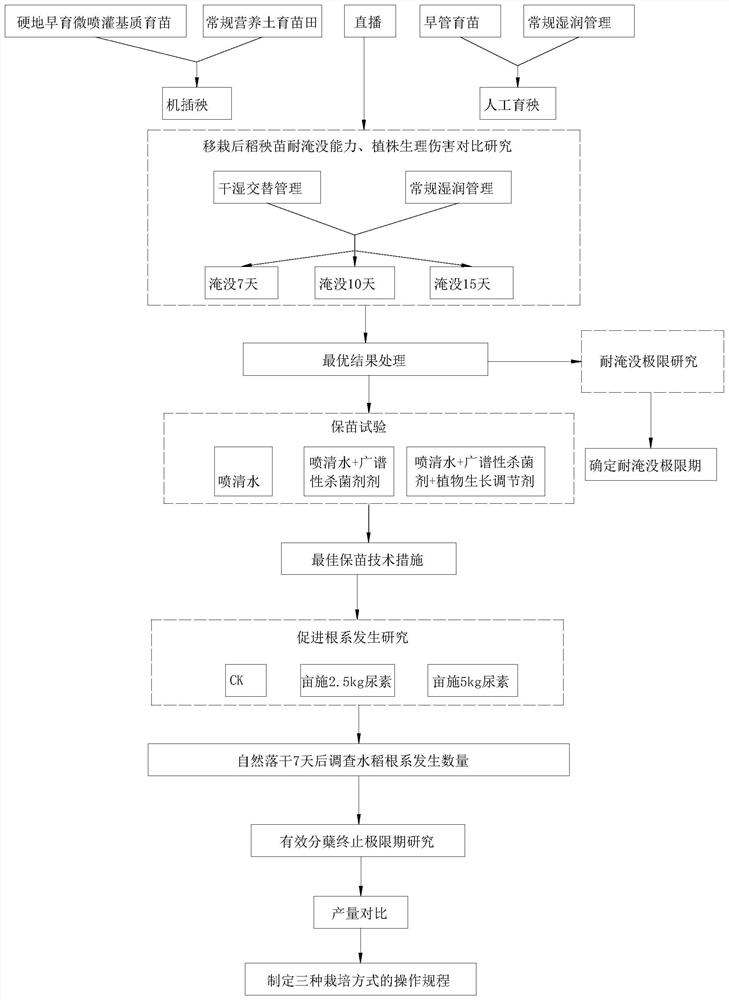Cultivation method of flood-disaster-resistant conventional japonica rice in Yangtze River basin
A flood-resistant and Yangtze River Basin technology, applied in the field of conventional japonica rice cultivation, can solve problems such as crop failure, large yield loss, and damage to seedlings
- Summary
- Abstract
- Description
- Claims
- Application Information
AI Technical Summary
Problems solved by technology
Method used
Image
Examples
Embodiment 2
[0039]A comparative study of the submergence resistance and plant physiological damage of conventional japonica rice seedlings in the tillering stage under different management measures under the machine-transplanted seedling cultivation method. A field of 8 mu with flat terrain and abundant water sources was selected and divided into 24 plots, each with an area of 0.3 mu. It is used to carry out experimental research, and three factors are set in the experiment, factor 1: two treatments of hard land and dry land substrate seedling raising method and conventional nutrient soil seedling raising method; Daejeon was managed with 2 treatments according to the conventional wet management method; factor 3: the field was flooded with water, and the inundation period was 7 days, 10 days, and 15 days respectively. Under different treatment conditions, the ability of rice seedlings to withstand submergence and the changes in the physiological damage of rice plants, find out the mechani...
Embodiment 3
[0041] A comparative study on the submergence resistance and plant physiological damage of conventional japonica rice seedlings in the tillering stage by using different management measures under artificial seedling transplanting cultivation methods. In the project unit, 8 mu of fields with flat terrain and abundant water sources were selected and divided into 24 plots. The area of the plot is 0.3 mu, which is used to carry out experimental research. Three factors are set in the experiment. Factor 1: the seedling field adopts dry management seedling raising method, and the seedling field adopts conventional wet management method. Management method management, after transplanting, the field was managed according to the conventional wet management method for 2 treatments; factor 3: the field was flooded with water, and the inundation period was 7 days, 10 days, and 15 days respectively. 3 treatments, 12 treatments, 2 repetitions, a total of 24 To study the submergence resistanc...
Embodiment 4
[0043] A comparative study of the submergence resistance and plant physiological damage of conventional japonica rice seedlings in the tillering stage under different management measures under the direct seeding cultivation method. In the project unit, a 4-mu field with flat terrain and abundant water sources was selected and divided into 6 plots. The area of each plot is 0.3 mu, used for experimental research, two factors were set in the experiment, factor 1: sowing on June 10, using alternate dry and wet management after live broadcast seedlings, and two treatments of conventional wet management after live broadcast seedlings; Factor 2: The field is flooded with water, and the submergence period is 7 days, 10 days, and 15 days. Three treatments, 6 treatments, and 12 plots were repeated twice to study the submergence resistance of rice seedlings and the physiology of rice plants under different treatments. The law of damage changes, find out the mechanism and method of enhan...
PUM
 Login to View More
Login to View More Abstract
Description
Claims
Application Information
 Login to View More
Login to View More - Generate Ideas
- Intellectual Property
- Life Sciences
- Materials
- Tech Scout
- Unparalleled Data Quality
- Higher Quality Content
- 60% Fewer Hallucinations
Browse by: Latest US Patents, China's latest patents, Technical Efficacy Thesaurus, Application Domain, Technology Topic, Popular Technical Reports.
© 2025 PatSnap. All rights reserved.Legal|Privacy policy|Modern Slavery Act Transparency Statement|Sitemap|About US| Contact US: help@patsnap.com


